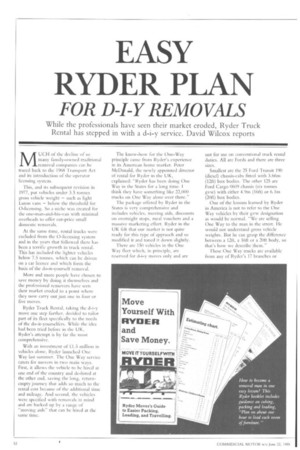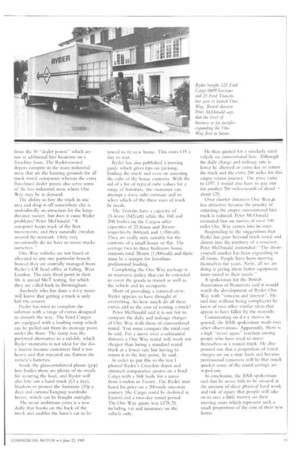EASY RYDER PLAN
Page 54

Page 55

If you've noticed an error in this article please click here to report it so we can fix it.
FOR D-I-Y REMOVALS
While the professionals have seen their market eroded, Ryder Truck Rental has stepped in with a d-i-y service. David Wilcox reports
MUCH of the decline of so many family-owned traditional removal companies can be traced back to the 1968 'transport Act and its introduction of the operator licensing system.
This, and its subsequent revision in 1977, put vehicles under 3.5 tonnes gross vehicle weight — such as light Luton vans — below the threshold for 0-licensing. So a niche was created for the one-man-and-his-van with minimal overheads to offer cut-price small domestic removals.
At the same time, rental trucks were excluded from the 0-licensing system and in the years that followed there has been a terrific growth in truck rental. This has included the lighter vehicles below 7.5 tonnes, which can be driven on a car licence and which form the basis of the do-it-yourself removal.
More and more people have chosen to save money by doing it themselves and the professional removers have seen their market eroded to a point where they now carry out just one in four or five moves.
Ryder Truck Rental, taking the d-i-y move one step further, decided to tailor part of its fleet specifically to the needs of the do-it-yourselfers. While the idea had been tried before in the UK, Ryder's attempt is by far the most comprehensive.
With an investment of ,21.5 million in vehicles alone, Ryder launched One Way last summer. The One Way service caters for movers in two main ways. First, it allows the vehicle to be hired at one end of the country and de-hired at the other end, saving the long, returnempty journey that adds so much to the rental cost because of the additional time and mileage. And second, the vehicles were specified with removals in mind and are backed up by a range of
"
tnoving aids" that can be hired at the same time. The know-how for the One-Way principle came from Ryder's experience in its American home market. Peter McDonald, the newly appointed director of rental for Ryder in the UK, explained: "Ryder has been doing One Way in the States for a long time. I think they have something like 22,000 trucks on One Way alone over there."
The package offered by Ryder in the States is very comprehensive and includes vehicles, moving aids, discounts on overnight stops, meal vouchers and a massive marketing effort. Ryder in the UK felt that our market is not quite ready for this type of app ranch and so modified it and toned it down slightly.
There are 150 vehicles in the One Way fleet which, in principle, are reserved for d-i-y moves only and are not for use on conventional truck rental duties. All are Fords and there are three sizes.
Smallest are the 25 Ford Transit 190 (diesel) chassis-cabs fitted with 3.66m (12ft) box bodies. The other 125 are Ford Cargo 0609 chassis (six tonnes gvw) with either 4.9m (16ft) or 6.1m (20ft) box bodies.
One of the lessons learned by Ryder in America is not to refer to the One Way vehicles by their gvw designation as would be normal. "We are selling One Way to the man in the street. He would not understand gross vehicle weights. But he can grasp the difference between a 12ft, a 16ft or a 201t body, so that's how we describe them."
These One Way trucks arc available from any of Ryder's 17 branches or from the 50 "dealer points" which arc run as additional hire locations on a franchise basis. The Ryder-owned depots compete in the main industrial areas that are the hunting grounds for all truck rental companies whereas the extra franchised dealer points also serve sonic of the less industrial areas where One Way may be in demand.
The ability to hire the truck in one area and drop it off somewhere else is undoubtedly an attraction for the longdistance mover, but does it cause Ryder problems? Peter McDonald; "A computer keeps track of the fleet movements, and they naturally circulate around the network. Only very occasionally do we have to move trucks ourselves.
One Way vehicles are not based or allocated to any one particular branch. Instead they are centrally managed from Ryder's UK head office at haling, West London. The only fixed point in their life is annual MoT testing, for which they are called back to Birmingham.
Anybody who has done a d-i-y move will know that getting a truck is only halt the answer.
Ryder has tried to complete the solution with a range of extras designed to smooth the way. The Ford Cargos are equipped with a loading ramp which can be pulled out from its stowage point under the floor. The ramp Was the preferred alternative to a tail-lift, which Ryder maintains is not ideal for the a-iy mover because customers find it too heavy and that repeated use flattens the vehicle's batteries.
Inside the glass-reinforced plastic (grp) box bodies there are plenty of tie retails for securing the load, and Ryder will also lure out a hand truck (.$113 a day), blankets to protect the furniture (10p a day) and cartons/hanging wardrobe boxes, which can be bought outright.
The most ambitious extra is a tow dolly that hooks on the back of the truck and enables the hirer's car to be
towed to its new home. This costs 05 a day to rent.
Ryder has also published a moving guide winch gives tips on packing, loading the truck and even on assessing the cube of the house contents. With the aid of a list of typical cube values for a range of furniture, the customer can attempt a d-i-y cube estimate and so select which of the three sizes of truck he needs.
The Transits have a capacity of 15.4cum (542cuft) while the 16ft and 20ft bodies on the Cargos offer capacities of 23.8cum and 30curn respectively (840cuft and 1,058cult). They are really only suitable for the contents of a small house or fiat. The average two to three bedroom house contents total 28cum (1,000cuft) and there must he a margin for less-thanprofessional loading.
Completing the One Way package is an insurance policy that can be extended to cover the goods in transit as well as die vehicle and its occupants.
Short of providing a removal crew, Ryder appears to have thought of everything. So how much do all these extras add to the cost of renting a truck?
Peter McDonald said it is not fair to compare the daily and mileage charges of One Way with those of conventional rental. You must compare the total cost he said. For a move over a substantial distance a One Way rental will work out cheaper than hiring a standard rental truck at a lower rate but having to return it to the hire point, he said.
In order to put this to the test I phoned Ryder's Croydon depot and obtained comparative quotes on a Ford Cargo with a 16ft body for a move from London to Exeter. The Ryder man .based Ins price on a 200-mile one-way journey (the Cargo could be de-hired in Exeter) and a two-day rental period. The One Way quote was 3:178.25, including vat and insurance on the vehicle only.
He then quoted for a similarly sized vehicle on conventional hire. Although the daily charge and mileage rate is lower he allowed an extra day to return the truck and the extra 200 miles for this empty return journey. 'I be price came to 097. I would also have to pay out for another 200 miles-worth of diesel about 3:.25.
Over shorter distances One Way.is less attractive because the penalty of returning the empty conventional hire truck is reduced. Peter McDonald estimated that on moves of over 100 miles One Way comes into its own.
Responding to the suggestions that Ryder has gone beyond truck rental and almost into the territory of a remover, Peter McDonald contended: "The
do-ityourself market has been expanding in all forms. People have been moving themselves for years. Now, all we are doing is giving them better equipment more suited to their needs."
A spokesman for the British Association of Removers said it would watch the development of Ryder One Way with "concern and interest-. I he said that without being complacent he knew of two other similar ideas that appear to have fallen by the wayside.
Commenting on d-i-y moves in general, the BAR spokesman made two other observations. Apparently, there is a high "never again" reaction among people who have tried to move themselves in a rented truck. He also pointed out that a proportion of rental charges are on a time basis and because professional removers will be that much quicker some of the rental savings are wiped out.
In conclusion, the BAR spokesman said that he never fails to he amazed at the amount of sheer physical hard work and risk of injury that people will take on to save a little money on their moving costs which represent such a small proportion of the cost of their new home.




































































































